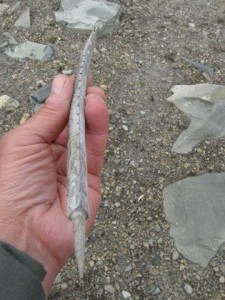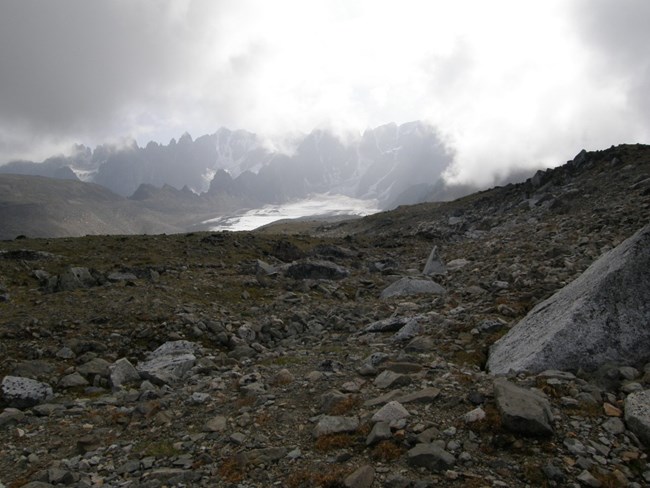Last updated: November 20, 2018
Article
History Preserved in Ice and Snow

NPS Photo
A Rare Find
The tip of a wooden arrow shaft, a section of an antler arrow point—rarely do archeologists find these types of organic objects preserved when they excavate a site. However, archeologists have found these types of things perfectly preserved in Lake Clark. Where? In ice and snow patches! These ice and snow patches in the park’s higher elevation areas have preserved organic material for hundreds and in some cases, even thousands of years. Also found in these ice patches are things like animal scat, antlers, fragments of ancient wood and horns—all hundreds of years old—traces of vanished ecosystems. The barbed projectile point highlighted in this article is a rare find.High elevation areas where ice patches form are not frequented by a significant number of people today—apart from mountain climbers and other adventurers, not many make the journey to these areas. In the past, however, people traveled to these places specifically because of the ice and snow patches. When winter snow accumulates in place, the snow can become thick enough to withstand summer temperatures. Over the years, the old snow stratifies into layers of ice. In the summer, these ice patches provide water, young plants at the margins, and most importantly, they also offer a cool refuge for animals fleeing biting insects. Humans naturally followed the animals. Anything that fell on top of these ice patches was encased in the ice and snow and preserved. Unlike glaciers, ice and snow patches do not move, so objects are not crushed or broken—generally where they fall is where they are found.
The high potential perennial snow and ice patches in Lake Clark are relatively low in elevation—and many have melted away due to global and regional climate change, resulting in fairly immediate loss of fragile organic artifacts once exposed to the air.

NPS Photo
Ice Patch Archeology
Lake Clark is responsible for stewardship of the material traces of our natural and cultural heritage, it is our responsibility to minimize the loss of these items. Recognizing ice patches and recovering the data they contain is also important for interpreting cultural ecology in high latitude/altitude regions, as well as understanding land use history. From 2008-2012, researchers from the University of New Mexico in collaboration with Lake Clark staff conducted an archaeological survey of perennial snow and ice patches in the high elevation areas. Ongoing ice patch research in Alaska, Canada, and other regions has uncovered extremely rare and exceptionally well-preserved organic artifacts.The work in Lake Clark was no different; it resulted in identification of three new archaeological sites and discovery of well-preserved organic artifacts that were new to Lake Clark. Two of the three sites discovered produced antler projectile points the third produced non-cultural bone fragments. Several shed caribou antlers and mammal bones at all the ice patches prove that caribou used the patches many times over the years.
At one of the sites, a single complete barbed antler point was recovered —this point is thought to be less than 200 years old based on morphology and weathering. Radiocarbon dating from this point backs this up—it had a date of around 150 years old. Also found at this site was a fragment of a large mammal long bone with cut marks on it—proof that humans had been successful in their hunt for big game. This site dates to the known historic Dena’ina occupation of the area.
At another site, two complete barbless antler points as well as a fragment of another antler point was collected. These are significantly older; the radiocarbon dates from these points came back about 1500-2000 years old. These earlier dates suggest that the Dena’ina people may have hunted caribou at these ice patches for at least the last 2,000 years.

NPS Photo
